Higgs Hoopla
Last 4th of July, scientists at the European Organization for Nuclear Research (also known as CERN — don’t ask me why) made the announcement that they have detected a particle that could possibly be the long sought after Higgs boson.
As a non-hipster science fan, I find it heartwarming that a scientific discovery made in the French-Swiss underground scene is finally making it into the mainstream. However, I noticed that many people are at a loss when it comes to comprehending the excitement surrounding this Higgs thingy. After all, where in the big picture of science does this so-called “God particle” fit in?
![Higgs boson memes [betabeat.com]](https://filipinofreethinkers.org/wp-content/uploads/2012/07/Higgs-boson-memes-betabeat.com_.jpg)
The Higgs boson is one of the few missing pieces of the Standard Model of particle physics. If the particle detected this week was indeed a Higgs boson, that’s +100 points for the Standard Model. The Standard Model is currently our best theory when it comes to explaining the behavior of our universe’s basic ingredients. Over past decades, it has been very successful at predicting how every known particle behaves and interacts.
If the universe is a stage, the Standard Model gives us the best insider story about the cast of characters and the role each character plays. Before we can describe what part the Higgs boson plays, we must first introduce the other members of the cast.
Enter the Leptons
The first members of the cast are the light leptons. There are six kinds of free-living leptons. The first three have charges, and they are called electrons, muons and tau particles. The next three don’t have charges, and they are called neutrinos. There are three kinds of neutrinos: electron neutrinos, muon neutrinos and tau neutrinos.
Electrons are part of the atoms that make up most of the material things we handle everyday. In fact, electrons are the first subatomic particles to be discovered. You can read this article on a computer screen only because humans have mastered the art of making electrons the way they want it to move.
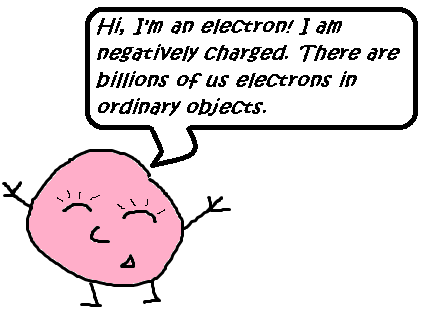
Muons are similar to electrons, only they are heavier and short-lived. Tau particles are even heavier and more short-lived! In particle physics jargon, we say that the electron is stable while the muon and tau particle are unstable. (Most people are, unfortunately, like muons in more ways than one.) It is because of their short lives that we do not meet muons and tau particles in our daily affairs.
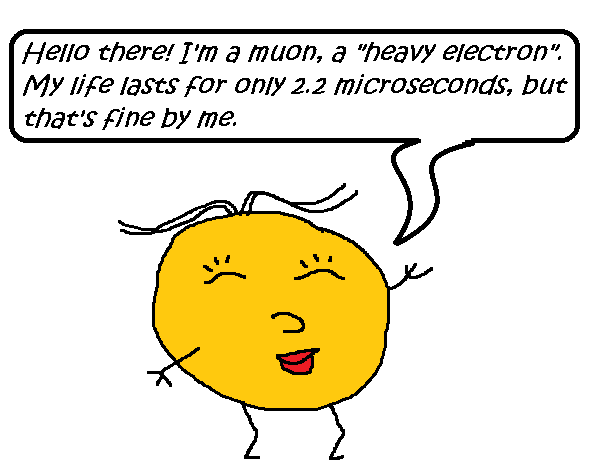
Neutrinos are very light and elusive particles. They are also neutrally charged, which means that they do not get repelled or attracted by other charges. In fact, they very seldom interact with other particles. This is why it took scientists a while before they finally detected them. In this regard, neutrinos are basically ninja particles!

Their elusiveness aside, neutrinos are actually everywhere! Right this instant, there are billions upon billions of neutrinos whizzing through your body like bullets flying though mist. You are not feeling it precisely because neutrinos mostly ignore other particles and are ignored by other particles. In fact, they can pass through the Earth like the Earth is not there.
Neutrinos recently made the news when some scientists thought they found neutrinos traveling faster than the speed of light. It was later discovered that neutrinos don’t break the universe’s speed limit after all.
Six Quarks for Muster Mark
The next members of our cast of characters are the quarks. There are also six of them: the up, down, charm, strange, top, and bottom quarks (aaawww yeah).
The six quarks are grouped according to “generation”. The up and down quarks belong to the first generation, the charm and strange to the second, and the top and bottom to the third. Quarks in each generation are heavier than those in the previous generation.
What distinguishes the quarks from the leptons is the fact that we do not find free-living quarks. Quarks are always tightly glued to other quarks to form hadrons. When a hadron is composed of a quark and its anti-quark glued together, we call it a meson. Meanwhile, when a hadron is composed of a triad of quarks, we call it a baryon.
You have quadrillions of hadrons in you, and so is the computer screen you are staring at right now. Why? Because the nucleus of atoms are made of protons and neutrons, and protons and neutrons are hadrons. To be more specific, they are baryons; protons and neutrons are made of three quarks glued together very tightly. The proton is made of two up quarks and one down quark while the neutron is made of one up quark and two down quarks.
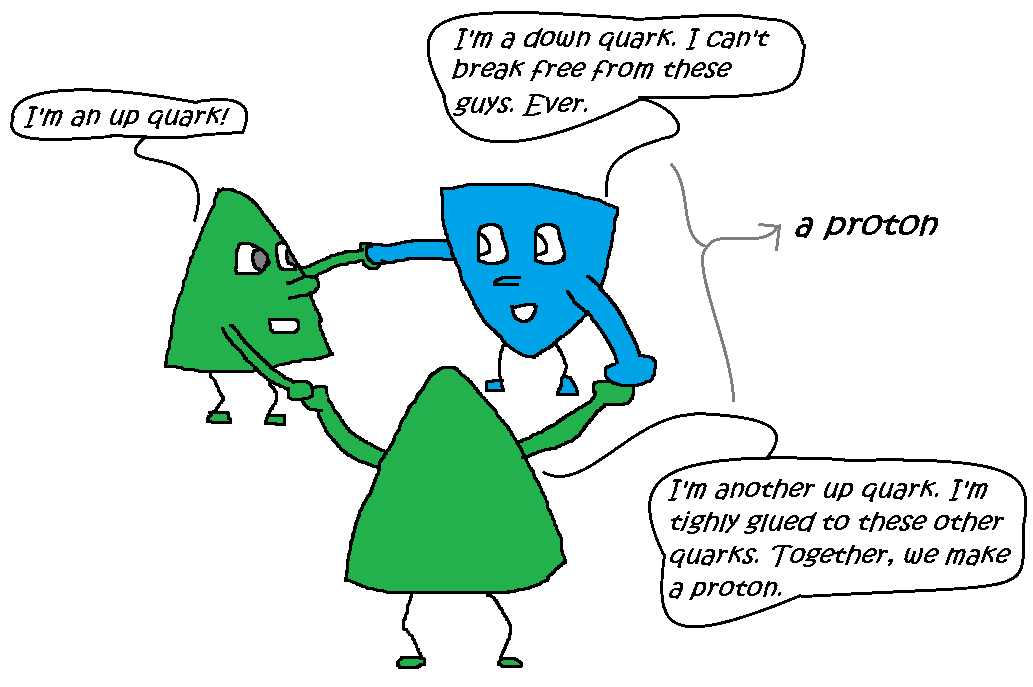
The Large Hadron Collider (LHC) of CERN is so-called because it was designed to smash together hadrons at very high speed. And also because it’s very large, as far as lab equipment go – it is found in a more or less circular tunnel 27 kilometers in circumference!
May the Force Carriers be with You
There are four fundamental forces: gravity, electromagnetic, weak, and strong. According to the Standard Model, the three forces aside from gravity are mediated by particles called force carriers.
Photons are the force carriers of the electromagnetic force. Photons are massless particles that travel at the speed of light, which is not surprising given that photons are the particles of light; light is but a stream of photons. Photons are also responsible for making like charges repel and unlike charges to attract. This means that without photons, atoms won’t exist either, because photons are what keep the electron around the nucleus! Without photons, the universe will be a very dark place indeed.
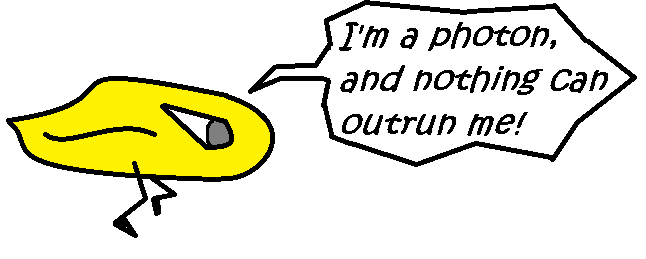
The force carriers of the strong force are called gluons, so-called because they form the “glue” that tightly binds quarks to form hadrons. Like photons, gluons are also massless. Without gluons, protons and neutrons won’t exist.

The weak force, on the other hand, is mediated by heavy force carriers called the W and Z bosons. These particles are around 80-90 times heavier than protons. The obesity of these force carriers is the reason why the weak force, unlike the electromagnetic force, has a very short range. The weak force can only act across distances smaller than an atom. But exotic as it may sound, the weak force is in fact very important to life on Earth. The weak force is responsible for some forms of radioactivity without which our Sun wouldn’t shine and the Earth’s interior wouldn’t be a dynamic fluid.
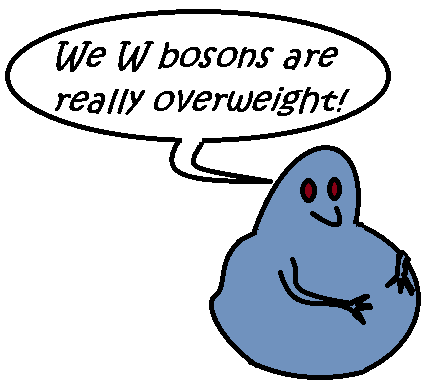
Of the three forces of the Standard Model, the weak is the weakest and the strong is the strongest (like duh). Compared to the electromagnetic force, the weak force is a trillion times weaker while the strong force is a hundred times stronger.
The Punch Line
The Standard Model makes many now well-confirmed predictions about the behavior of the particles that make up our world, but there’s a catch: it seems to say that all the particles of the model (the six leptons, six quarks and the force carriers) have to be massless. Except for photons and gluons, which are indeed massless, this is clearly not the case. This is a problem of the theory. And it’s a major one, too.
This is where the Higgs boson comes to the Standard Model’s rescue. Higgs bosons provide a mechanism that imbues some particles with mass. This happens because Higgs bosons, which are everywhere in the universe, “couple” with some particles and thus supply them mass. The stronger the coupling of the Higgs bosons with a certain particle, the more massive that particle becomes. (Unfortunately, for people who want to lose weight really quickly, changing how you couple with Higgs bosons is not an option.)
In a universe without Higgs bosons, the Standard Model predicts that all particles will be massless and they will all zip across space at the speed of light. Since we find ourselves living in a universe where only photons and gluons can travel at the speed of light, then either Higgs bosons exist or the Standard Model is wrong after all. The discovery of the Higgs boson is therefore a major triumph of the Standard Model.
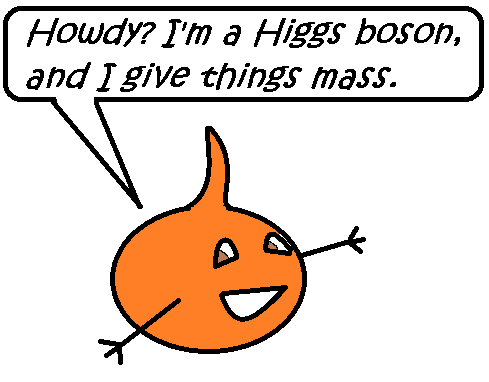
In Search of a New Standard
To date, the Standard Model is one of two best theories about the universe. However, it still has a lot of problems. For one, it does not say anything about gravity. For another, it goes haywire when combined with the other theory we have of the universe, General Relativity.
Gravity is the weakest of the four fundamental forces; it is literally weaker than weak. In fact, it is weaker than the weak force by a factor of 10^25 or a thousand million quadrillions! That is why in the world of tiny particles, gravity is negligible. Another problem with gravity is that the Standard Model says nothing about it. But it is the force that keeps you anchored to the Earth, the force that keeps the planets tethered to the Sun, and the force that herds stars into galaxies and galaxies into clusters. Gravity, weak as it may be, is a force to be reckoned with.
Our best theory for gravity is Einstein’s General Relativity, which explains that gravity is the curvature of space and time. General Relativity has passed all experimental and observational tests with flying colors. It powerfully explains the behavior of the universe as a whole from its earliest stages up to the present. But it is not friends with the Standard Model, something that bothers physicists to no end. This is especially bothersome given that the origin of our universe, the moments approaching the Big Bang, is subject to both the laws of General Relativity and the Standard Model.
Another problem with the Standard Model is that it accounts for only 4% of the universe! As for the other 96%, it has nothing to say. In fact, the other 96% is so mysterious to us that we decided to simply call them “dark matter” and “dark energy,” which just goes to show that we know next to nothing about them, except that they exist. (IMHO, calling the other 96% “love” would have been apt.)
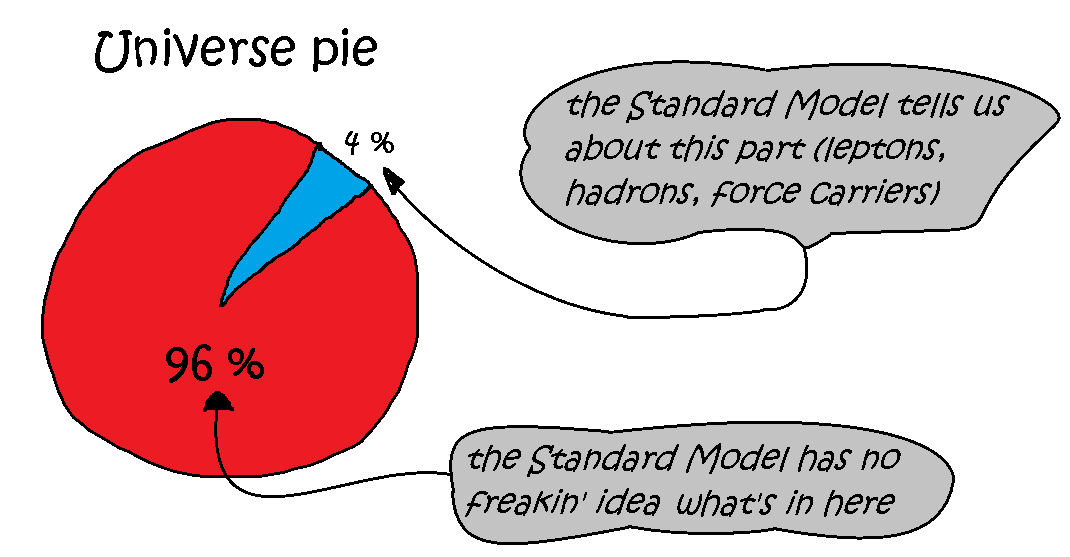
The Search Goes On
Let us summarize what we have talked about. The Standard Model is our best theory about the composition of our universe. It tells us that the universe is composed of six leptons that can fly around freely (like electrons and neutrinos), six quarks that are always glued to other quarks (protons and neutrons are just quarks glued together), and force carriers that mediate the interactions between the other particles. But the Standard Model can only account for the mass of some of the particles if a particle known as the Higgs boson exists. If the particle detected last week was a Higgs boson, it would be a major triumph for the Standard Model.
However, it is apparent that the Standard Model cannot be the last say. It has its own problems, chief among these is that it cannot explain gravity, it is not compatible with our best theory explaining gravity, and it can account for only 4% of the universe. And so the search for the solution to the problem of existence has not ended. In fact, the discovery of the Higgs boson opens the door for more furious research; in other words, the search has only begun.


[…] 1: Without You by David Guetta & Usher It is explained here how the strength of coupling of the massive particle with the Higgs field relates to the value of […]
One more item: the statement of 4% being explained by the SM is misleading. Given the vacuum expectation value of the Higgs field. If this new particle is indeed the quantum of the Higgs field, then there will be quite some (dark) energy it can account for.
Source: e.g. http://www.sciencedaily.com/releases/2007/05/0705…
Thanks for the correction, Andre! Should I say instead that the 4% is the total mass of the other particles of the Standard Model (sans Higgs boson)? I want to avoid calling it "ordinary matter" or "baryonic matter". Thanks again!
Hi Pecier. Thanks again for having written the article.
I was trying to figure out how much the vacuum expectation value of the Higgs field could contribute to the cosmological constant and could not find if it is a decent contribution or something negligible in face of the cosmological measurements of the last decades.
The 4% are visible matter, i.e., matter that interacts with photons. The problem is that the SM may also explain some of the "invisible" stuff. But I need to stop doing this handwaving and get some hard numbers. Unlikely to be anytime soon 🙁
I have enjoyed the tone of this article a lot. It emphasizes the right thing: it's the beginning.
One week ago we had no idea where to look next. Now we have found the door that opens in a maze of locked doors. Next comes crossing its threshold and experiencing what's beyond it.
That's what I love about science: closing a door means that you have entered a new room full of new doors to try.
ps – I am among the people who nailed this thing.
Loved the article! There is something I would like to point out though. Higgs bosons don’t give mass. It is the Higgs field, that permeates across the universe that gives the mass. The Higgs boson is a quanta of that field. Just like the saying the Photon is the quanta of the Electromagnetic Field. The Higgs boson at 125 giga-electronvolts, is so massive that it instantaneously decays into other particles. It can’t possibly attach itself to other particles to give them mass. Detecting a quanta of the Higgs field, which is the Higgs boson (or as scientists put it, a particle consistent with the predictions of the Higgs boson) proves the existence of the field.
Saying that the Higgs boson "gives" particles mass is, of course, just a metaphor, and any metaphor taken too far would lead to error. However, I took the risk of using the metaphor for the sake of accessibility.
Obviously, the more precise way of explaining the Higgs mechanism is by saying that the massive particle "couples" with the Higgs field, and the strength of the coupling is related to the value of the mass. I gave this explanation in the body of the article. But for the picture, I opted for the less precise but more accessible and briefer metaphor of "mass endowment".
I hope you see my point. xD
Not a lot of Physicists would go out of their way and speak in this language to cater to the common man. Thanks for making it more digestible for the likes of me.
There is a subtle point here: the Higgs field was not designed to give mass to all particles, but to solve the electroweak symmetry breaking problem: why are Z and W weak bosons so massive when their electromagnetic counterpart, the photon, massless.
Once there was a mechanism that sorted this out, then the coupling of the Higgs with all other particles (fermions) was just pegged to this. The coupling structure, for instance, is completely different, the Higgs couples linearly via a Yukawa structure to the fermions.
So, one of the hot questions about the neutral massive boson we have found is wether it couples to fermions and bosons as the SM Higgs is supposed to.
NB: what was discovered is a neutral massive boson. We still do not know if it is the Higgs boson. It is a good candidate. But we are not sure.
Think of a safari: we just shot something that has 4 legs and a tail. But it's dark and we are deaf, so we have yet to figure out if it is a zebra, a tiger, a lion, an elephant, a crocodile…
Conseil Européen pour la Recherche Nucléaire (European Council for Nuclear Research) was the previous name of the current CERN. Thus, CERN.
CERN is NOT the previous name. It IS the present name IN FRENCH.
Wrong!
CERN, the Conseil Europeen pour la Recherche Nucleaire was the entity that precede the establishment of the European Organization for Nuclear Research.
The acronym stuck and it has been CERN ever since.
Source: http://public.web.cern.ch/public/en/About/Name-en…
NO. Current french name is Organisation européenne pour la recherche nucléaire, a direct translation from the current English name. (Or the current English name is a translation from the current French name, to be exact) 😉